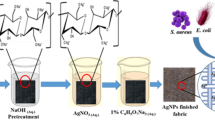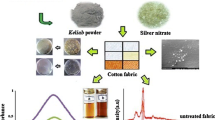Abstract
In this research, the cotton fabric was modified with bismuth oxide nanoparticles (Bi2O3 NPs) by a simple method. Bismuth oxide nanoparticles were synthesized by chemical reduction of bismuth salt using nitric acid as reducing agent. In situ method was used for synthesis and deposition of bismuth oxide nanoparticles on cotton fabrics. The samples were characterized by X-ray diffraction for evaluation of crystal structure, scanning electron microscopy for presentation of morphology and size, energy-dispersive X-ray spectroscopy for determination of chemical composition, atomic absorption spectroscopy for studding bismuth release, contact angle for explanation of hydrophobic character, and diffuse reflection spectroscopy for ultraviolet (UV) blocking. The antibacterial activity was evaluated by measurement of the reduction of the gram-negative Escherichia coli on modified cotton fabric. Based on the results, modified cotton fabric showed hydrophobic, UV-blocking properties, and antibacterial activity as compared with control cotton fabric, which will have high potential applications in various fields.








Similar content being viewed by others
References
AbdElhady MM (2012) Preparation and characterization of chitosan/zinc oxide nanoparticles for imparting antimicrobial and UV protection to cotton fabric Int. J Carbohydr Chem 2012:1–7
Abudayyak M, Oztas E, Arici M, Ozhan G (2017) Investigation of the toxicity of bismuth oxide nanoparticles in various cell lines. Chemosphere 169:117–123
Anandan S, Wu J (2009) Microwave assisted rapid synthesis of Bi2O3 short nanorods. J Mater Lett 63:2387–2389
Arjomandi M, Shirkhanloo H (2019) A review: analytical methods for heavy metals determination in environment and human samples. AMECJ 2(3):97–126
Bagheri Hosseinabadi M, Timoori S, Faghihi Zarandi F (2019) Functionalized graphene-trimethoxyphenyl silane for toluene removal from workplace air by sorbent gas extraction method. AMECJ 2(2):45–54
Becenen N (2017) UV protection and wettability properties for cotton fabric using ZnO nanoparticles. IJACEBS 4(1):13–14
Carotenuto G, Hison CL, Capezzuto F, Palomba M (2009) Synthesis and thermoelectric characterisation of bismuth nanoparticles. J Nanopart Res 11(7):1729–1738
d’Agua RB, Branquinho R, Duarte MP, Maurício E, Fernando AL, Martins R, Fortunato E (2018) Efficient coverage of ZnO nanoparticles on cotton fibres for antibacterial finishing using a rapid and low cost in situ synthesis. New J Chem 2:1–22
Davari S, Davari F, Shirkhanloo H (2018) Dispersive solid phase microextraction based on aminefunctionalized bimodal mesoporous silica nanoparticles for separation and determination of calcium ions in chronic kidney disease. AMECJ 1(1):57–66
Ebnerasool FS, Motakef Kazemi N (2019) Preparation and characterization of chitosan nanocomposite based on nanoscale silver and nanomontmorillonite. AMECJ 2(2):5–12
El-Shishtawy RM, Asiri AM (2011) In situ production of silver nanoparticle on cotton fabric and its antimicrobial evaluation. Cellulose 18:75–82
Fouda MM, Abdel-Halim ES, Al-Deyab SS (2013) Antibacterial modification of cotton using nanotechnology. Carbohydr Polym 92:943–954
Gou M, Bahrami Yarahmadi B (2019) Removal of ethylbenzene from air by graphene quantum dots and multi wall carbon nanotubes in present of UV radiation. AMECJ 2(4):59–70
Gujar TP, Shinde VR, Lokhande CD, Mane RS, Han SH (2006) Formation of highly textured (111) Bi2O3 films by anodization of electrodeposited bismuth films. Appl Surf Sci 252:2747–2751
Gujar TP, Shinde VR, Lokhande CD (2008) The influence of oxidation temperature on structural, optical and electrical properties of thermally oxidized bismuth oxide films. Appl Surf Sci 254:4186–4190
Hajiashrafi S, Motakef-Kazemi N (2018) Green synthesis of zinc oxide nanoparticles using parsley extract. Nanomed Res J 3(1):44–50
Hajiashrafi S, Motakef-Kazemi N (2019) Preparation and evaluation of ZnO nanoparticles by thermal decomposition of MOF-5. Heliyon 5:e02152
Huang YJ, Zheng YQ, Zhu HL, Wang JJ (2016) Hydrothermal synthesis of bismuth(III) coordination polymer and its transformation to nano α-Bi2O3 for photocatalytic degradation. J Solid State Chem 239:274–281
Jamshidzadeh C, Shirkhanloo H (2019) A new analytical method based on bismuth oxide-fullerene nanoparticles and photocatalytic oxidation technique for toluene removal from workplace air. AMECJ 2(1):73–86
Jassim AMN, Farhan SA, Salman JAS, Khalaf KJ, Al Marjani MF, Mohammed MT (2015) Study the antibacterial effect of bismuth oxide and tellurium nanoparticles. Int J Chem Biol Sci 1(3):81–84
Jiang T, Liu L, Yao J (2011) In situ deposition of silver nanoparticles on the cotton fabrics. Fiber Polym 12(5):620–625
Karst D, Yang Y (2006) Potential advantages and risks of nanotechnology for textiles. AATCC Rev 6:44–48
Kim H, Jin C, Park S, Lee WI, Chin IJ, Lee C (2013) Structure and optical properties of Bi2S3 and Bi2O3 nanostructures synthesized via thermal evaporation and thermal oxidation routes. Chem Eng J 215:151–156
La J, Huang Y, Luo G, Lai J, Liu C, Chu G (2012) Synthesis of bismuth oxide nanoparticles by solution combustion method. Part Sci Technol 31(3):287–290
Li R, Che J, Zhang H, He J, Bahi A, Ko F (2014) Study on synthesis of ZnO nanorods and its UV-blocking properties on cotton fabrics coated with the ZnO quantum dot. J Nanopart Res 16:2581
Liang TT, Guo XG (2019) Remarkably facile preparation of superhydrophobic functionalized bismuth trioxide (Bi2O3) coatings. Appl Sci 9(13):2653
Mädler L, Pratsinis SE (2004) Bismuth oxide nanoparticles by flame spray pyrolysis. J Am Ceram Soc 85(7):1713–1718
Mahmoudi Alashti T, Motakef kazemi N, Shojaosadati SA (2020) In situ production and deposition of nanosized zinc oxide on cotton fabric. IJCCE (accepted)
Mallahi M, Shokuhfar A, Vaezi MR, Esmaeilirad A, Mazinani V (2014) Synthesis and characterization of bismuth oxide nanoparticles via sol–gel method. AJER 3(4):162–165
Mehmandoust MR, Motakef-Kazemi N, Ashouri F (2019) Nitrate adsorption from aqueous solution by metal–organic framework MOF-5. Iran J Sci Technol Trans Sci 43(2):443–449
Mehring M (2007) From molecules to bismuth oxide-based materials: potential homo- and heterometallic precursors and model compounds. Coord Chem Rev 251:974–1006
Motakef Kazemi N (2019) A novel sorbent based on metal–organic framework for mercury separation from human serum samples by ultrasound assisted- ionic liquid-solid phase microextraction. AMECJ 2(3):67–78
Motakef Kazemi N, Asghar Salimi A (2019) Chitosan nanoparticle for loading and release of nitrogen, potassium, and phosphorus nutrients. Iran J Sci Technol Trans Sci 43(6):2781–2786
Motakef Kazemi N, Yaqoubi M (2020) Green synthesis and characterization of bismuth oxide nanoparticle using mentha pulegium extract. IJPR (accepted)
Motakef Kazemi N, Rashidian M, Taghizadeh Dabbagh S, Yaqoubi M (2019) Synthesis and characterization of bismuth oxide nanoparticles by thermal decomposition of bismuth-based MOF and evaluation of its nanocomposite. IJCCE (accepted)
Nazari P, Faramarzi MA, Sepehrizadeh Z, Mofid MA, Bazaz RD, Shahverdi AR (2012) Biosynthesis of bismuth nanoparticles using Serratia marcescens isolated from the Caspian Sea and their characterization. IET Nanobiotechnol 6(2):58–62
Palasantzas G, De Hosson JTM (2001) Wetting on rough surface. Acta Mater 49:3533–3538
Perez-Mezcua D, Sirera R, Jimenez R, Bretos I, De Dobbelaere C, Hardy A, Baelc MKV, Lourdes Calzada M (2014) A UV-absorber bismuth(III)-Nmethyldiethanolamine complex as a lowtemperature precursor for bismuth-based oxide thin films. J Mater Chem C 2:8750–8760
Rajendran R, Balakumar C, Mohammed Ahammed HA, Jayakumar S, Vaideki K, Rajesh EM (2010) Use of zinc oxide nano particles for production of antimicrobial textiles. Int J Eng Sci Technol 2(1):202–208
Rohani Saad S, Mahmed N, Mustafa Al Bakri Abdullah M, Victor Sandu A (2016) Self-cleaning technology in fabric: a review. Mater Sci Eng 133:012028
Schulz S, Heimann S, Wölper C, Assenmacher W (2012) Synthesis of bismuth pseudocubes by thermal decomposition of Bi2Et4. Chem Mater 24(11):2032–2039
Solanki PR, Singh J, Rupavali B, Tiwari S, Malhotra BD (2017) Bismuth oxide nanorods based immunosensor for mycotoxin detection. Mater Sci Eng C 70:564–571
Souza DAR, Gusatti M, Ternus RZ, Fiori MA, Riella HG (2018) In situ growth of ZnO nanostructures on cotton fabric by solochemical process for antibacterial purposes. J. Nanomater 2018:1–9
Sricharussin W, Threepopnatkul P, Neamjan N (2011) Effect of various shapes of zinc oxide nanoparticles on cotton fabric for UV-blocking and anti-bacterial properties. Fiber Polym 12(8):1037–1041
Sze Tung W, Daoud WA (2010) Self-cleaning wool: effect of formulation concentration on low-stress mechanical and surface properties. RJTA 14(2):83–88
Torrisi L, Silipigni L, Restuccia N, Cuzzocrea S, Cutroneo M, Barreca F, Fazio B, Di Marco G, Guglielmino S (2018) Laser-generated bismuth nanoparticles for applications in imaging and radiotherapy. J Phys Chem Solids 119:62–70
Wu J, Qin F, Lu Z, Yang HJ, Chen R (2011) Solvothermal synthesis of uniform bismuth nanospheres using poly(N-vinyl-2-pyrrolidone) as a reducing agent. Nanoscale Res Lett 6(1):66–74
Xia F, Xu X, Li X, Zhang L, Zhang L, Qiu H, Wang W, Liu Y, Gao J (2014) Preparation of bismuth nanoparticles in aqueous solution and its catalytic performance for the reduction of 4-Nitrophenol. Ind Eng Chem Res 53(26):10576–10582
Zhang F, Wu X, Chen Y, Lin H (2009) Application of silver nanoparticles to cotton fabric as an antibacterial textile finish. Fiber Polym 10(4):496–501
Zolfonoun E (2018) Solid phase extraction and determination of indium using multiwalled carbon nanotubes modified with magnetic nanoparticles. AMECJ 1(1):5–10
Zulfiqar AR (2018) In situ synthesis and immobilization of nanosilver on knitted cellulose fabric. J Nat Fibers 15(2):183–190
Zulkifli ZA, Razak KA, Rahman WNWA, Abidin SZ (2018) Synthesis and characterisation of bismuth oxide nanoparticles using hydrothermal method: the effect of reactant concentrations and application in radiotherapy. J Phys Conf Ser 1082:012103
Author information
Authors and Affiliations
Corresponding author
Rights and permissions
About this article
Cite this article
Motakef Kazemi, N., Sandalnia, M. In Situ Production and Deposition of Bismuth Oxide Nanoparticles on Cotton Fabric. Iran J Sci Technol Trans Sci 44, 1217–1223 (2020). https://doi.org/10.1007/s40995-020-00916-1
Received:
Accepted:
Published:
Issue Date:
DOI: https://doi.org/10.1007/s40995-020-00916-1




